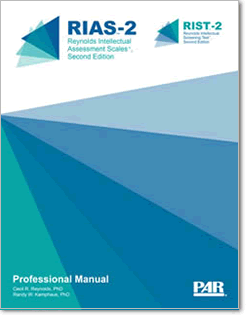
Reynolds Intellectual Screening Test™, Second Edition rist-2
Authors: Randy W. Kamphaus, PhD, and Cecil R. Reynolds, PhD
Purpose: Screens for general intelligence
Format: Paper and pencil, Online scoring via PARiConnect, E-Manual, Download
Age range: 3 years to 94 years
Time: 10-15 minutes
Online Forms, Reports, Kits & e-Manuals
Click to browse products
Printed Kits
Click to browse products
Printed Forms & Handscoring Materials
Test forms, response booklets and scoring reference manuals.
RIST-2 online Interpretive Report (each) min order 5
RIST-2 Introductory Kit
RIST-2 Record Forms (25)
PAR’s new In-Person e-Stimulus Books and Kits are convenient, more hygienic alternatives to paper administration that allow you to administer the RIAS-2 and RIST-2 face-to-face via tablet.
Developed to provide a quick and reliable screening measure of general cognitive aptitude, the RIST-2 is ideal for identifying individuals who may need a more comprehensive assessment of intelligence in a variety of settings. The RIST-2 also can be useful in clinical and school practice when a global estimate of intelligence is all that is needed.
Test structure
Derived from the updated RIAS-2 subtests, the RIST-2 retains the same two subtests as the original RIST: Guess What and Odd-Item Out. Guess What, a verbal subtest, which is a traditional measure of crystallized intelligence; and Odd-Item Out, a nonverbal subtest, which focuses on fluid intelligence.
Technical information
The RIST-2 normative sample is the same as that for the RIAS-2, which was updated to reflect the most recent U.S. Census.
Percentile ranks, 90% and 95% confidence intervals, T scores, z scores, NCEs, and stanines are available.
Criterion-related validity was assessed via correlations with the WISC-IV™ FSIQ (.68), WAIS-IV™ FSIQ (.62), WPPSI-IV™ FSIQ (.62), AAB Composite (.53), FAR Total Index (.40), and ChAMP Total Memory Index (.51). Score correlations strongly suggest the RIST-2 is an appropriate screener for intelligence.
Validity of the RIST-2 was assessed in studies with stroke, dementia, hearing impairment, traumatic brain injury, intellectual disability disorder, ADHD, learning disability, and gifted clinical groups. The RIST-2 can effectively identify individuals with an intellectual impairment.
Correlations between the RIST-2 index and RIAS-2 subtests were .84 and .87, respectively, for Guess What and Odd-Item Out.



